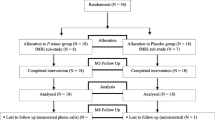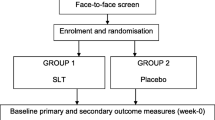Abstract
Background
The aim of the study was to evaluate the effects of N-Pep-12 dietary supplementation on neurorecovery of middle-aged and older adults with cognitive impairment after ischemic stroke, using neuropsychological outcome scales.
Methods
This was a pilot randomized-controlled, phase IV, academic clinical trial that aimed to assess the effect and the safety of a single daily dose of oral 90 mg of N-Pep-12 for 90 days in supporting neurorecovery, as compared with a control group, performed on middle-aged and older adults after supratentorial ischemic stroke.
Results
Study group differences in baseline changes at day 90 for Montreal Cognitive Assessment (MoCA), Hospital Anxiety and Depression Scale (HADS) - Anxiety subscale, Color Trails 1 and Symbol Search (number incorrect) were statistically significant (Mann-Whitney U test). For MoCA at day 90, a borderline ‘intermediate effect’ in favour of N-PEP-12 was observed (dCohen = 0.491, η2 = 0.057, OR = 2.436, p = 0.010). HADS Anxiety and Color Trails 1 at day 90 registered a ‘small-to-intermediate’ effect in favour of N-PEP-12 (dCohen = 0.424, η2 = 0.043, OR = 2.157, p = 0.026; dCohen = 0.481, η2 = 0.055, OR = 2.3927, p = 0.013, respectively). For symbol search errors, an ‘intermediate’ effect in favour of the control group was observed (dCohen = 0.501, η2 = 0.059, OR = 2.4811, p = 0.007).
Conclusion
This exploratory clinical trial indicates a signal for the benefit of dietary supplementation with N-Pep-12 for the enhancement of neurorecovery after supratentorial ischemic stroke.


Similar content being viewed by others
References
Avan A, Digaleh H, Di Napoli M et al (2019) Socioeconomic status and stroke incidence, prevalence, mortality, and worldwide burden: an ecological analysis from the Global Burden of Disease Study 2017. BMC Med 17:191–191. https://doi.org/10.1186/s12916-019-1397-3
Cucchiara B, George DK, Kasner SE, Knutsson M, Denison H, Ladenvall P, Amarenco P, Johnston SC (2019) Disability after minor stroke and TIA: a secondary analysis of the SOCRATES trial. Neurology 93:e708–e716. https://doi.org/10.1212/WNL.0000000000007936
Shavelle RM, Brooks JC, Strauss DJ, Turner-Stokes L (2019) Life expectancy after stroke based on age, sex, and rankin grade of disability: a synthesis. J Stroke Cerebrovasc Dis 28:104450. https://doi.org/10.1016/j.jstrokecerebrovasdis.2019.104450
Mijajlović MD, Pavlović A, Brainin M, Heiss WD, Quinn TJ, Ihle-Hansen HB, Hermann DM, Assayag EB, Richard E, Thiel A, Kliper E, Shin YI, Kim YH, Choi SH, Jung S, Lee YB, Sinanović O, Levine DA, Schlesinger I, Mead G, Milošević V, Leys D, Hagberg G, Ursin MH, Teuschl Y, Prokopenko S, Mozheyko E, Bezdenezhnykh A, Matz K, Aleksić V, Muresanu DF, Korczyn AD, Bornstein NM (2017) Post-stroke dementia - a comprehensive review. BMC Med 15:11–11. https://doi.org/10.1186/s12916-017-0779-7
Jellinger KA (2013) Pathology and pathogenesis of vascular cognitive impairment-a critical update. Front Aging Neurosci 5:17–17. https://doi.org/10.3389/fnagi.2013.00017
Sachdev PS, Brodaty H, Valenzuela MJ, Lorentz L, Looi JCL, Wen W, Zagami AS (2004) The neuropsychological profile of vascular cognitive impairment in stroke and TIA patients. Neurology 62:912–919. https://doi.org/10.1212/01.wnl.0000115108.65264.4b
Sörös P, Harnadek M, Blake T, Hachinski V, Chan R (2015) Executive dysfunction in patients with transient ischemic attack and minor stroke. J Neurol Sci 354:17–20. https://doi.org/10.1016/j.jns.2015.04.022
Douiri A, Rudd AG, Wolfe CDA (2013) Prevalence of poststroke cognitive impairment: South London Stroke Register. Stroke 44:138–145. https://doi.org/10.1161/STROKEAHA.112.670844
Gutiérrez Pérez C, Sävborg M, Påhlman U, Cederfeldt M, Knopp E, Nordlund A, Åstrand R, Wallin A, Fröjd K, Wijk H, Tarkowski E (2011) High frequency of cognitive dysfunction before stroke among older people. Int J Geriatr Psychiatry 26:622–629. https://doi.org/10.1002/gps.2573
Sun J-H, Tan L, Yu J-T (2014) Post-stroke cognitive impairment: epidemiology, mechanisms and management. Ann Transl Med 2:80–80. https://doi.org/10.3978/j.issn.2305-5839.2014.08.05
Hernández-Hernández EM, Caporal Hernandez K, Vázquez-Roque RA, Díaz A, de la Cruz F, Florán B, Flores G (2018) The neuropeptide-12 improves recognition memory and neuronal plasticity of the limbic system in old rats. Synapse 72:e22036. https://doi.org/10.1002/syn.22036
Hutter-Paier B, Reininger-Gutmann B, Wronski R, Doppler E, Moessler H (2015) Long-term treatment of aged Long Evans rats with a dietary supplement containing neuroprotective peptides (N-PEP-12) to prevent brain aging: effects of three months daily treatment by oral gavage. J Med Life 8:207–212
Windisch M, Hutter-Paier B, Grygar E, Doppler E, Moessler H (2005) N-PEP-12 – a novel peptide compound that protects cortical neurons in culture against different age and disease associated lesions. J Neural Transm 112:1331–1343. https://doi.org/10.1007/s00702-005-0283-7
Alvarez XA, Corzo L, Laredo M et al (2005) Neuropeptide dietary supplement N-PEP-12 enhances cognitive function and activates brain bioelectrical activity in healthy elderly subjects. Methods Find Exp Clin Pharmacol 27:483–487. https://doi.org/10.1358/mf.2005.27.7.914776
Crook TH, Ferris SH, Alvarez XA, Laredo M, Moessler H (2005) Effects of N-PEP-12 on memory among older adults. Int Clin Psychopharmacol 20:97–100. https://doi.org/10.1097/00004850-200503000-00006
Aben I, Verhey F, Lousberg R, Lodder J, Honig A (2002) Validity of the beck depression inventory, hospital anxiety and depression scale. Psychosomatics 43:386–393. https://doi.org/10.1176/appi.psy.43.5.386
Pendlebury ST, Mariz J, Bull L, Mehta Z, Rothwell PM (2013) Impact of different operational definitions on mild cognitive impairment rate and MMSE and MoCA performance in transient ischaemic attack and stroke. Cerebrovasc Dis 36:355–362. https://doi.org/10.1159/000355496
Poon W, Vos P, Muresanu D, Vester J, von Wild K, Hömberg V, Wang E, Lee TMC, Matula C (2015) Cerebrolysin Asian Pacific trial in acute brain injury and neurorecovery: design and methods. J Neurotrauma 32:571–580. https://doi.org/10.1089/neu.2014.3558
Quinn TJ, Langhorne P, Stott DJ (2011) Barthel index for stroke trials: development, properties, and application. Stroke 42:1146–1151. https://doi.org/10.1161/STROKEAHA.110.598540
Lenhard W, Lenhard A Calculation of effect sizes. Psychometrica. https://doi.org/10.13140/RG.2.2.17823.92329
Fritz CO, Morris PE, Richler JJ (2012) Effect size estimates: current use, calculations, and interpretation. J Exp Psychol Gen 141:2–18. https://doi.org/10.1037/a0024338
Cohen B (2014) Explaining psychological statistics, 4th edn. Wiley, New York
Cohen J (1988) Statistical power analysis for the behavioral sciences. Lawrence Erlbaum Associates, Hillsdale
Borenstein M, Hedges LV, Higgins JPT, Rothstein HR (2009) Introduction to meta-analysis. Wiley
Rahlfs V, Zimmermann H (2019) Effect size measures and their benchmark values for quantifying benefit or risk of medicinal products. Biom J 61:973–982. https://doi.org/10.1002/bimj.201800107
Bernhardt J, Hayward KS, Kwakkel G, Ward NS, Wolf SL, Borschmann K, Krakauer JW, Boyd LA, Carmichael ST, Corbett D, Cramer SC (2017) Agreed definitions and a shared vision for new standards in stroke recovery research: the Stroke Recovery and Rehabilitation Roundtable taskforce. Int J Stroke 12:444–450. https://doi.org/10.1177/1747493017711816
Muresanu DF (2008) Neuroplasticity and neurorecovery. pp 37–49
Muresanu DF, Strilciuc S, Stan A (2019) Current drug treatment of acute ischemic stroke: challenges and opportunities. CNS Drugs 33:841–847. https://doi.org/10.1007/s40263-019-00663-x
Author information
Authors and Affiliations
Corresponding author
Ethics declarations
Conflict of interest
The authors declare that they have no conflict of interest.
Ethics approval
All procedures performed involving human participants were in accordance with the 1964 Helsinki Declaration and its later amendments, recommendations of good clinical practice of the International Conference on Harmonization (2001/20/EEC, CPMP/ICH/135/95). The study was approved on 10/12/2015, by the Ethics Committee of the Iuliu Hatieganu University of Medicine and Pharmacy (8 Babeş Street, 400012 Cluj-Napoca, Romania), reference number 507/10.12.2015, amended 82/24/03/2016, 104/12/02/2018. Amendments were submitted to adapt outcome scales prior to study initiation and to correct minor protocol inconsistencies.
Ethics approval
An informed consent form was obtained from each participant of the study.
Additional information
Publisher’s note
Springer Nature remains neutral with regard to jurisdictional claims in published maps and institutional affiliations.
Electronic supplementary material
ESM 1
(DOCX 28 kb)
Rights and permissions
About this article
Cite this article
Balea, M., Birle, C., Costin, C. et al. Effects of N-Pep-12 dietary supplementation on neurorecovery after ischemic stroke. Neurol Sci 42, 2031–2037 (2021). https://doi.org/10.1007/s10072-020-04707-9
Received:
Accepted:
Published:
Issue Date:
DOI: https://doi.org/10.1007/s10072-020-04707-9




